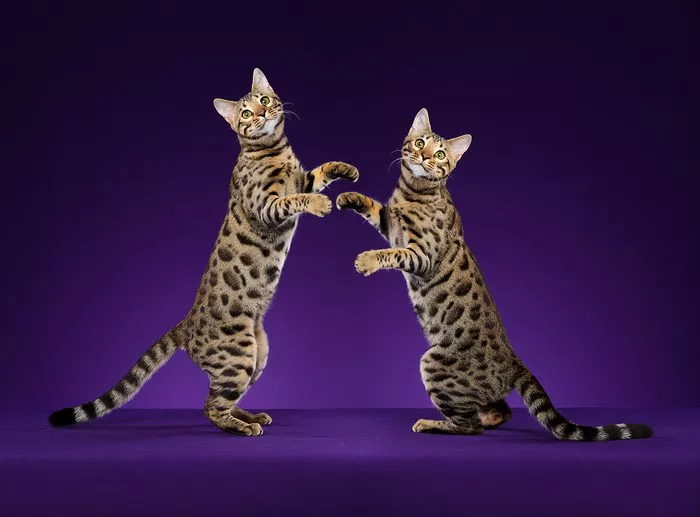Bengal cats, with their distinctive spotted or marbled coats and lively personalities, are known for their playful and energetic nature. To engage their curious minds and channel their abundant energy, training Bengal cats to fetch can be both entertaining and rewarding. In this comprehensive guide, we will explore the steps and techniques to unlock the fetching potential in your Bengal feline companion. From understanding their natural instincts to employing positive reinforcement, discover the art of transforming your Bengal cat into a fetching aficionado.
Understanding Bengal Cats
1. Curious Hunters by Nature:
Bengal cats have a rich heritage rooted in their wild ancestors, particularly the Asian leopard cat. This ancestry contributes to their curious and adventurous nature. Bengals are natural hunters, exhibiting a keen interest in interactive play and activities that mimic hunting behaviors.
2. Energetic and Agile Athletes:
Known for their athleticism, Bengal cats are agile and possess a high energy level. Keeping them mentally stimulated is crucial to their well-being. Fetch is an excellent way to engage their physical prowess and tap into their natural instincts in a controlled and enjoyable manner.
3. Bonding through Play:
Training your Bengal cat to fetch not only provides mental and physical exercise but also strengthens the bond between you and your feline companion. The interactive nature of fetch creates positive associations with playtime, fostering a deeper connection between the two of you.
Preparing for Fetch Training
1. Choose the Right Toys:
Begin by selecting the right toys for fetch. Bengal cats often prefer toys that mimic prey, such as small soft balls, crinkly toys, or plush mice. Opt for lightweight toys that are easy for them to carry and suitable for interactive play.
2. Identify Your Cat’s Preferences:
Every Bengal cat has unique preferences when it comes to toys. Some may prefer small, tossable objects, while others may be drawn to toys with feathers or strings. Observe your cat’s reactions during play to identify the toys that capture their interest and enthusiasm.
3. Create a Positive Environment:
Fetch training should take place in a positive and distraction-free environment. Choose a quiet room where your Bengal cat feels comfortable and safe. Minimize potential distractions to focus their attention on the training process.
Building Basic Play and Retrieval Skills
1. Interactive Play Sessions:
Before introducing the concept of fetch, engage in interactive play sessions with your Bengal cat. Use the chosen toys to mimic prey-like movements, encouraging them to pounce, chase, and bat at the toys. This helps build their interest and excitement for play.
2. Introduce the Fetching Concept:
Once your Bengal cat is actively participating in play, introduce the concept of fetch. Gently roll or toss the toy a short distance, allowing your cat to observe its movement. Bengals are often attracted to objects in motion, and their natural instincts may kick in, prompting them to investigate the toy.
3. Encourage Retrieval:
To encourage retrieval, use positive reinforcement. When your Bengal cat shows interest in the toy or approaches it, offer verbal praise, gentle petting, or a small treat. Reinforce the positive behavior associated with interacting with the toy.
Gradual Progression and Patience
1. Incremental Distance:
Gradually increase the distance you toss the toy as your Bengal cat becomes more comfortable with the fetching concept. Start with short distances and progressively extend the range. Pay attention to their level of interest and adjust the difficulty accordingly.
2. Repetition and Consistency:
Like any training process, repetition and consistency are key to success. Practice fetch in short sessions regularly to reinforce the behavior. Consistency helps your Bengal cat understand the desired outcome, making the training process more effective.
3. Understanding Individual Preferences:
Each Bengal cat has unique preferences and learning styles. Some may quickly grasp the fetch concept, while others may require more time and patience. Pay attention to your cat’s cues and tailor the training approach to suit their individual temperament.
Advanced Techniques for Fetch Training
1. Introduce Retrieval Commands:
As your Bengal cat becomes more proficient in fetching, introduce simple retrieval commands. Use consistent verbal cues such as “fetch” or “bring it back” while engaging in the play session. Reinforce the commands with positive reinforcement to establish a connection between the verbal cue and the desired behavior.
2. Incorporate Challenges:
To keep fetch sessions engaging, incorporate challenges or variations. Place the toy on elevated surfaces, behind obstacles, or in different rooms. These challenges stimulate your Bengal cat’s problem-solving skills and maintain their interest in the fetch game.
3. Rotate Toys:
Bengal cats may show more interest in fetch if the toys are rotated regularly. Introduce a variety of toys and switch them out periodically to prevent boredom. This keeps the game dynamic and prevents your cat from losing interest in the fetching activity.
Troubleshooting and Overcoming Challenges
1. Lack of Interest:
If your Bengal cat shows a lack of interest in fetch, reassess the chosen toys. Experiment with different textures, shapes, and sizes to identify the toys that capture their attention. Be patient and allow them to explore at their own pace.
2. Short Attention Span:
Bengal cats are known for their curiosity, but they may have a relatively short attention span. Keep fetch sessions short and engaging to prevent boredom. Gradually extend the duration as your cat becomes more accustomed to the game.
3. Incorporate Treats as Rewards:
If your Bengal cat needs additional motivation, incorporate treats as rewards. When they successfully retrieve the toy, offer a small treat as positive reinforcement. This reinforces the connection between the desired behavior and a rewarding outcome.
Fostering a Positive Fetching Experience
1. Celebrate Success:
Celebrate each successful fetch with enthusiasm. Verbal praise, gentle petting, and positive affirmations create a positive association with the fetching activity. Make the experience enjoyable for your Bengal cat to encourage continued participation.
2. Be Patient and Flexible:
Patience is a virtue in the training process. If your Bengal cat encounters challenges or setbacks, remain patient and flexible in your approach. Adjust the training techniques based on their responses and preferences, allowing the process to unfold organically.
3. Enjoy the Bonding Experience:
Beyond the practical benefits of fetch training, relish the bonding experience with your Bengal cat. The interactive play and positive interactions strengthen the connection between you and your feline companion, creating lasting memories and shared moments of joy.
Conclusion
Training your Bengal cat to fetch is a delightful journey that taps into their natural instincts and provides mental and physical stimulation. By understanding their unique characteristics, incorporating positive reinforcement, and being patient, you can transform your Bengal cat into a fetching enthusiast. Embrace the playful spirit of your Bengal feline companion, and revel in the joy of a shared activity that fosters a deep and meaningful connection between you and your cat.
























